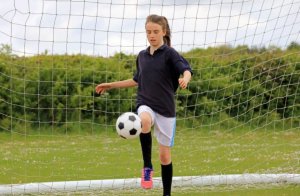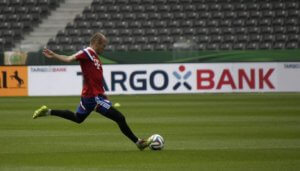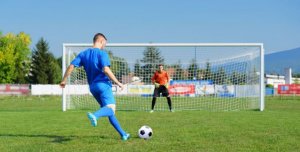Which Muscles Do We Use For Kicking a Ball?

Every sport has its own unique requirements. For example, players who have an outstanding ability for kicking a ball are usually in the spotlight of soccer; this allows them to score from far away and perform long passes easily. If you’ve ever wanted to imitate them, you’ve probably wondered which muscles we use for kicking a ball? We’ll tell you all about it in this article.
A powerful kick can make a soccer player stand out and be remembered forever. Roberto Carlos, Siniša Mihajlović and Dejan Stanković are notable examples of amazing kickers that have performed many outstanding free kicks in soccer.
A great kick can be a striking skill in other sports too. For example, in rugby, where kicking is important to clear the ball.
Many soccer and amateur rugby players want to mimic this talent. Competing against other players with the same level of skill, can offer a great advantage.

But to do so, they must exercise their legs. Specifically, it’s essential to know which muscles we need to use for kicking a ball. In this article we’ll delve deeper and give you some advice to boost these “weapons” that allow you to score goals and clear the ball.
Muscles we use for kicking a ball
The most involved muscle group for kicking a ball, is the one in the upper part of your legs. It includes the quadriceps, hamstrings and glutes. However, you also need to exert force with your central muscles -this muscle group is known as your core- and includes your hips, the muscles in your feet and even your torso and shoulders.
As you can see, most of your body is involved in kicking movements. This is because, beyond the specific force of your feet, you are basically using your whole body to make the kick more powerful.
Quadriceps, hamstrings and glutes
These muscles are responsible for flexing and extending the knee in the leg that you use to kick the ball with. And these movements also affect your hip flexors, as they are joined together through the femur.
Your hips are in charge of articulating your leg movements. Along with the glutes, they help to extend your leg backwards when you’re gaining momentum.
Most noteworthy are the quadriceps and hamstrings of your support leg, as these provide you with the necessary stability. This way, you can kick in the right direction and as hard as you want.
Core muscles
Just like the previous set of muscles, these ones contribute to your stability and they also help with the kicking movement.
Torso and shoulders
While kicking is mostly done using your legs, it’s impossible to do it without moving your chest and shoulders. This is because they play a fundamental role in keeping your balance and making sure you don’t fall down.
Deltoid muscles align your shoulders with the ball during a kick as well. This serves as a coordinating action and it helps to transmit strength to the kick.
Tibialis anterior and calves
The tibialis anterior is a muscle in the outer side of the tibia. If you’re wondering what it does when kicking a ball, the answer is that it helps you to flex your ankle articulations.
When you kick a ball, your ankle bends. If you point your toes downward, you’re performing a plantar flexion; but if you point them upwards, you’re performing a dorsal flexion. The tibialis anterior comes into play when you make a dorsal flexion. What’s more, when you make a plantar flexion, your calves and soleus muscles are involved.

Tips for better kicking
Now that you know the basic points about the muscles that you use for kicking a ball, you can move on to practicing this movement. Here is some advice to improve your kicking; useful for soccer and other sports too:
- Place your support foot next to the ball. You should flex the knee on that leg slightly.
- If you want your kick to be more powerful, try extending your leg back as far as possible as you gain momentum.
- Keep the ankle of your kicking foot firm and secure to achieve a powerful and stable shot.
- If you don’t want the ball to lift off of the ground too much, try leaning forwards when you kick. Your head should align with the ball, from this moment.
- On the contrary, if you want to kick the ball higher, lean your body backwards. This way, the ball will follow an upward trajectory.
- Try to kick with the part of your foot where the laces are, unless you want the ball to follow a curved path.
Finally, you can also look into other types of kicking that require more technique than force, such as the curl or the bend.
However, you’ll improve your ability by following a good leg routine that will help you to gain power and kick in the right form. Knowing which muscles you use for kicking a ball will help you to focus on your movements and perform them more accurately.
Every sport has its own unique requirements. For example, players who have an outstanding ability for kicking a ball are usually in the spotlight of soccer; this allows them to score from far away and perform long passes easily. If you’ve ever wanted to imitate them, you’ve probably wondered which muscles we use for kicking a ball? We’ll tell you all about it in this article.
A powerful kick can make a soccer player stand out and be remembered forever. Roberto Carlos, Siniša Mihajlović and Dejan Stanković are notable examples of amazing kickers that have performed many outstanding free kicks in soccer.
A great kick can be a striking skill in other sports too. For example, in rugby, where kicking is important to clear the ball.
Many soccer and amateur rugby players want to mimic this talent. Competing against other players with the same level of skill, can offer a great advantage.

But to do so, they must exercise their legs. Specifically, it’s essential to know which muscles we need to use for kicking a ball. In this article we’ll delve deeper and give you some advice to boost these “weapons” that allow you to score goals and clear the ball.
Muscles we use for kicking a ball
The most involved muscle group for kicking a ball, is the one in the upper part of your legs. It includes the quadriceps, hamstrings and glutes. However, you also need to exert force with your central muscles -this muscle group is known as your core- and includes your hips, the muscles in your feet and even your torso and shoulders.
As you can see, most of your body is involved in kicking movements. This is because, beyond the specific force of your feet, you are basically using your whole body to make the kick more powerful.
Quadriceps, hamstrings and glutes
These muscles are responsible for flexing and extending the knee in the leg that you use to kick the ball with. And these movements also affect your hip flexors, as they are joined together through the femur.
Your hips are in charge of articulating your leg movements. Along with the glutes, they help to extend your leg backwards when you’re gaining momentum.
Most noteworthy are the quadriceps and hamstrings of your support leg, as these provide you with the necessary stability. This way, you can kick in the right direction and as hard as you want.
Core muscles
Just like the previous set of muscles, these ones contribute to your stability and they also help with the kicking movement.
Torso and shoulders
While kicking is mostly done using your legs, it’s impossible to do it without moving your chest and shoulders. This is because they play a fundamental role in keeping your balance and making sure you don’t fall down.
Deltoid muscles align your shoulders with the ball during a kick as well. This serves as a coordinating action and it helps to transmit strength to the kick.
Tibialis anterior and calves
The tibialis anterior is a muscle in the outer side of the tibia. If you’re wondering what it does when kicking a ball, the answer is that it helps you to flex your ankle articulations.
When you kick a ball, your ankle bends. If you point your toes downward, you’re performing a plantar flexion; but if you point them upwards, you’re performing a dorsal flexion. The tibialis anterior comes into play when you make a dorsal flexion. What’s more, when you make a plantar flexion, your calves and soleus muscles are involved.

Tips for better kicking
Now that you know the basic points about the muscles that you use for kicking a ball, you can move on to practicing this movement. Here is some advice to improve your kicking; useful for soccer and other sports too:
- Place your support foot next to the ball. You should flex the knee on that leg slightly.
- If you want your kick to be more powerful, try extending your leg back as far as possible as you gain momentum.
- Keep the ankle of your kicking foot firm and secure to achieve a powerful and stable shot.
- If you don’t want the ball to lift off of the ground too much, try leaning forwards when you kick. Your head should align with the ball, from this moment.
- On the contrary, if you want to kick the ball higher, lean your body backwards. This way, the ball will follow an upward trajectory.
- Try to kick with the part of your foot where the laces are, unless you want the ball to follow a curved path.
Finally, you can also look into other types of kicking that require more technique than force, such as the curl or the bend.
However, you’ll improve your ability by following a good leg routine that will help you to gain power and kick in the right form. Knowing which muscles you use for kicking a ball will help you to focus on your movements and perform them more accurately.
This text is provided for informational purposes only and does not replace consultation with a professional. If in doubt, consult your specialist.








